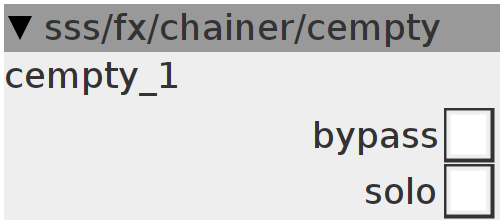cempty
This is an empty module (audio-thru) to use with the chainfx module. You can use this module to fill up empty slots on the chainfx module or to add your own custom effect codes by embedding this module and editting the code. Note that it is object-oriënted. This module won't feature audio in/out pins, but could use external control input to edit internal parameters (eg. see the VCA module controlling the volume with an input pin to make a gapped/enveloped signal)
Inlets
None
Outlets
None
Parameters
bool32.tgl bypass
bool32.tgl solo
Declaration
// always keep these the same names, as these are the "general in/out names"
int32_t outL, outR;
int32_t IL, IR;
bool bypass, solo;
// I often use names like "v30" to save powers of 2, saves up some calculation
// time.
uint32_t v30 = (uint32_t)1 << 30;
uint32_t v26 = (uint32_t)1 << 26;
uint32_t v27 = (uint32_t)1 << 27;
// this is the code for the effect
// Don't change the inL/inR, IL/IR outL/outR names!
int32_t FX(int32_t inL, int32_t inR, int32_t CV1, int32_t CV2) {
IL = inL; // this saves the left input so the effect can be bypassed
IR = inR; // this saves the right input so the effect can be bypassed
// enter code below:
// here you can enter your code. Use inL and inR to get the audio left&right
// input. the below code puts the calculated audio into "outL" and "outR" as
// output of the FX.
outL = inL; // this is the left output of the fx (puts inL into outL)
outR = inR; // this is the right output of the fx (puts inR into outR)
if (bypass > 0) {
outL = IL; // when bypass is on, sends IL to left output of effect function
outR = IR; // when bypass is on, sends IR to right output of effect function
}
};
Control Rate
bypass = param_bypass;
solo = param_solo;